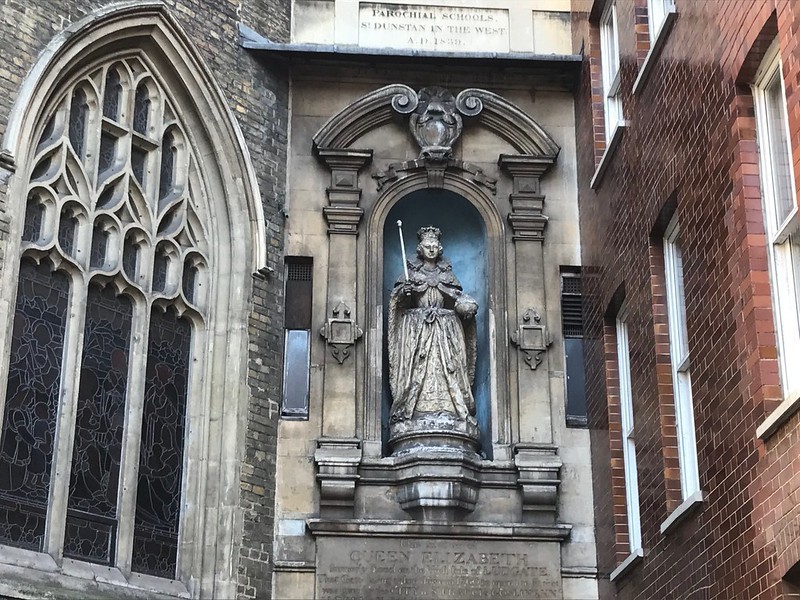Edinburgh has its Royal Mile, Westminster has The Mall, but the City of London has its own regal parade in the shape of Fleet Street.
This ancient road has been the quickest land route between the commercial centre of the City and the Royal and Parliamentary centre of Westminster since medieval times. Fleet Street was big long before the newspaper industry.
The route is, in fact, lined with royalty, though you often have to keep your eyes peeled to spot their many Highnesses.
The Street of Three Queens

The regal procession begins at the Temple Bar memorial, the point near the Royal Courts where Strand becomes Fleet Street. This dragon-topped pedestal marks the original site of Christopher Wren's Temple Bar, a ceremonial gateway between Westminster and the City that was taken down in 1878.
On the side of this memorial stands a statue of Queen Victoria, the last monarch to pass through the old gateway before its demolition. Her lapidarius majesty looks a little grumpy, as though she's not enjoying her demotion to stone gatekeeper. Victoria was carved by Joseph Boehm, whose many other works include the magnificent seated statue of Charles Darwin in the Natural History Museum.

Her illustrious predecessor Elizabeth I can be seen a little further down Fleet Street, tucked away in a recess of St Dunstan-in-the-West. She too was once a gatekeeper, standing guard over the ancient Ludgate until it was dismantled in 1760. Dating from 1586, this may well be London's oldest statue (though King Alfred in Southwark might dispute that). Despite almost half a millennium on the job, good Queen Bess looks much happier than Queen Vic.

Our third queen is perhaps the least noticed. She is Mary Queen of Scots, and she stands at first floor level in a building next to Ye Olde Cheshire Cheese. The tragic queen was carved in 1905 to adorn the premises of a Scottish insurance company. Given Mary's close connections with France (she spent her childhood there, and was briefly Queen Consort), it's fitting that she stands above a branch of Pret a Manger, a British chain pretending to be French.
Yet More Royalty
If we're prepared to climb the hill of Ludgate, then we can easily add a fourth queen to our haul. St Paul's Cathedral's west front is overseen by the likeness of Queen Anne who, like Elizabeth and Victoria, carries the orb and sceptre. She's actually a late Victorian copy of an earlier statue that had become badly weathered. The base is original, though, and designed by Christopher Wren.

Hard over to the north stands Wren's Temple Bar, which started life in the same place as this article, at the point where Strand becomes Fleet Street. It's moved around a few times over the years, including a spell in Theobalds Park, Hertfordshire, before settling down as the entrance to a revived Paternoster Square in the Noughties. This commanding structure is itself covered in royalty, including James I, his wife Queen Anne of Denmark, Charles I, and Charles II.
Here's a geeky fact... if you stand in just the right spot in Paternoster Square, you can spy two Queen Anne statues: the one to Queen Anne of Great Britain outside St Paul's, and the Temple Bar statue of Anne of Denmark.

We're not quite done with the royalty yet. If we backtrack down the hill to Fleet Street, we can bag at least two more kings. Keeping Elizabeth company in the porch of St Dunstan's is the statue group of King Lud and his sons. Lud is a mythical king, said by some medieval texts to have been a pre-Roman founder of London.
Queen Vic on the Temple Bar memorial is also kept company by a future king. Her son Edward VII, who was Prince of Wales at the time of the monument's erection, stands in statue form on the northern side. He looks much happier than his illustrious mum.
And one final king on Fleet Street that very few people notice. Look down at your feet when entering one of those narrow alleyways to the north and you might just spot this plaque to the King of Rock and Roll.

So that's 11 kings and queens in the short stretch between St Paul's and the start of Strand. Fleet Street and Ludgate is London's Royal Third-of-a-Mile.




